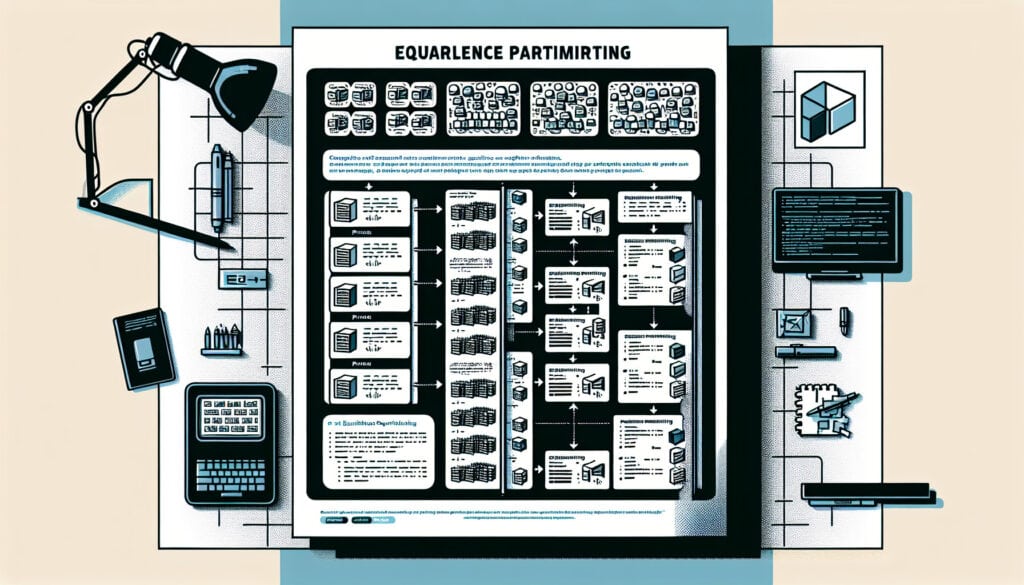Reducir el número de casos de prueba a un nivel manejable manteniendo una cobertura de pruebas razonable.
- Metodologías: Clientes y marketing, Ideación, Diseño de producto
Partición por equivalencia

Partición por equivalencia
- Metodología ágil, Mejora continua, Mejora de procesos, Seguro de calidad, Control de calidad, Gestión de calidad, Pruebas de software, Métodos de ensayo, Validación
Objetivo:
Cómo se utiliza:
- Divides the input data of a software unit into partitions of equivalent data from which test cases can be derived. The assumption is that if one value in a partition works, all values in that partition will work.
Ventajas
- Reduces the number of test cases needed; Efficiently covers a wide range of inputs.
Contras
- May not catch errors at the boundaries of partitions; Requires careful analysis to define partitions correctly.
Categorías:
- Ingeniería, Calidad
Ideal para:
- Efficiently testing software applications with a large number of possible inputs.
Equivalence Partitioning is particularly advantageous in software testing phases, primarily during system and integration testing, where the focus is on validating the functionality of software applications with diverse input ranges. This methodology sees prevalent applications across various sectors such as finance, healthcare, telecommunications, and e-commerce, where applications frequently handle extensive input domains, including user inputs, transaction data, and configuration settings. For instance, in an online payment system, inputs could include transaction amounts, card numbers, and expiration dates, where partitioning can isolate valid and invalid ranges, thereby ensuring comprehensive coverage without exhaustive testing. Initiators of this methodology typically include quality assurance teams and test engineers, often in collaboration with software developers to create effective test cases that efficiently validate software behavior in real-world scenarios. Participants in this process usually encompass stakeholders from development, testing, and product management to ensure a diverse perspective on potential inputs and their expected outcomes. The systematic approach of Equivalence Partitioning not only provides efficient coverage of functional requirements but also significantly reduces the overhead associated with manual test case creation while enhancing test reliability.
Pasos clave de esta metodología
- Identify the input data that the software unit can accept.
- Divide the input data into equivalence classes based on similar behavior.
- Determine valid and invalid partitions for each class.
- Select test cases from each partition, aiming for representative values.
- Execute test cases to verify functionality across partitions.
Consejos profesionales
- Incorporate boundary análisis de valor with equivalence partitioning to enhance test coverage and identify edge cases effectively.
- Regularly review and update partitions as requirements evolve to ensure that all relevant input scenarios remain covered.
- Utilize automated testing tools that support equivalence partitioning to swiftly generate and manage test cases based on defined partitions.
Leer y comparar varias metodologías, recomendamos el
> Amplio repositorio de metodologías <
junto con otras más de 400 metodologías.
Sus comentarios sobre esta metodología o información adicional son bienvenidos en la dirección sección de comentarios ↓ , así como cualquier idea o enlace relacionado con la ingeniería.
Contexto histórico
1900
1900-12-14
1902
1907
1915
1915-11
1918
1895
1900
1902
1904
1913
1915
1916
1919-05-29
(si se desconoce la fecha o no es relevante, por ejemplo "mecánica de fluidos", se ofrece una estimación redondeada de su notable aparición)















Publicaciones relacionadas
Cuestionarios sobre molestias musculoesqueléticas
Pruebas multivariantes (MVT)
Análisis de regresión múltiple
Sistemas de captura de movimiento
Método MoSCoW
Prueba de la mediana de Mood